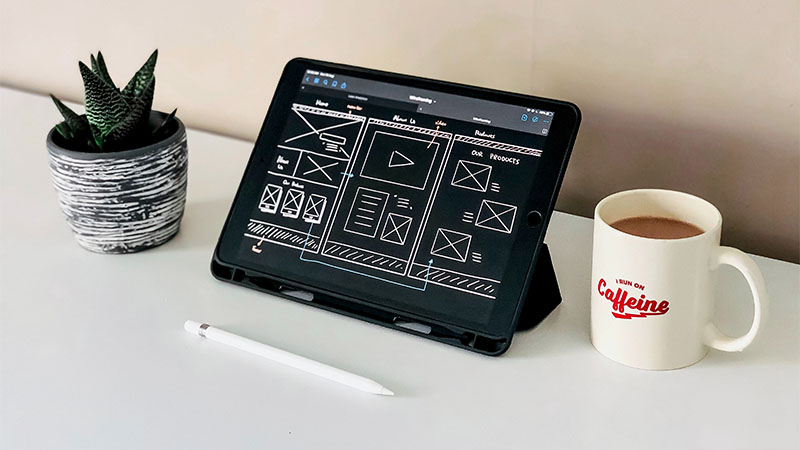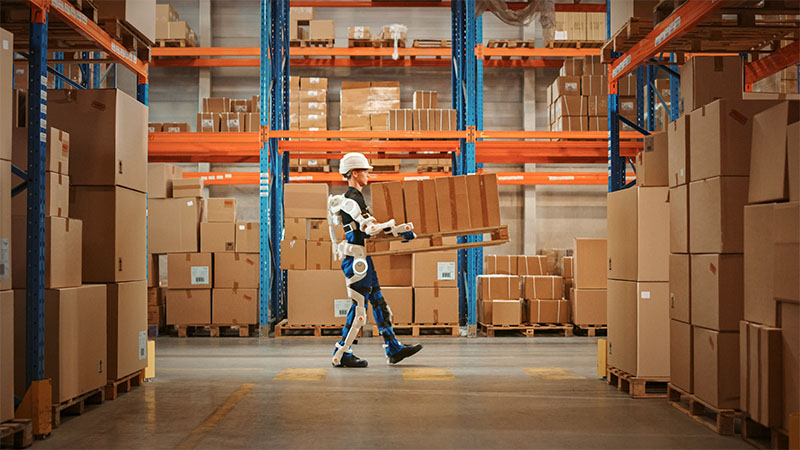Grow your business with the Discover newsletter
Logistics advice & insights straight to your inbox
Subscribe now
E-commerce is the buying and selling of goods and services over the internet. It differs from traditional commerce which is focused on the exchange of products and services, but face-to-face. E-commerce has the benefit of 24/7 availability, and a global scope.
Thanks to rapid digitalisation, e-commerce is becoming a regular habit for many people across the world. It’s estimated that 2.14 billion people purchased something online in 20211 – that’s 27% of the global population!

There are several types of e-commerce:
B2C – business-to-consumer. This is the one that you are probably most familiar with. It involves online businesses – typically retailers – selling products and services directly to consumers. Examples include grocery and apparel brands, small businesses with their own e-commerce website, and subscription-based services, like Netflix.
B2B – business-to-business. This involves electronic transactions of goods and services between businesses. Examples include commerce wholesale, where the buyer then sells on to an end customer (B2B to B2C). B2B e-commerce is a fast-growing sector; typically negotiations would have been done in person, but due to digitalisation, much of it is moving online.
C2C – consumer-to-consumer. This involves the electronic transactions of goods and services between consumers. Typically, these are conducted via a third-party online platform, such as eBay or Facebook Marketplace.
C2B – consumer-to-business. This is where consumers sell their products or services to businesses. Examples include online influencers selling ad space on their blog, or a photographer selling their images to businesses via a dedicated platform like Shutterstock.
Any small or existing business looking to grow should make e-commerce a central part of their strategy. It’s a lucrative opportunity, and it has never been easier to set up an online store. The many benefits include:
It’s growing – and fast. Global e-commerce sales are expected to increase 10.4% in 2023, to a market value of US$6.3 trillion2. This already impressive number is forecast to hit over US$8.1 trillion by 2026 – a staggering rise for a three-year period. Internet and smartphone penetration rates continue to climb across the world – even in developing countries – meaning e-commerce’s potential reach is limitless.
Low operating costs. Setting up an online store is much more affordable than a bricks-and-mortar outlet, without the need to pay for rent, store design and staff. Budding e-commerce entrepreneurs can start small, selling on an online marketplace like eBay, which has relatively low risks associated. There are also many low-cost marketing tools at your disposal – setting up a brand page on Instagram, for example, is free, and is a powerful way to engage with thousands, if not millions, of potential customers.
Global reach. Thanks to the growth of international shipping, it has never been easier to open your online store to the world. Of course, this requires some market research into which countries are hot buyers of your products, and ensuring your e-commerce website is customized for local buyers (think language and payment methods), but the opportunity to maximise your sales is vast.
Powerful customer data. You can’t improve your business without really knowing your customers, and this is where e-commerce really thrives. As an online seller, you’ll have access to invaluable behavioral data about your customers: how they arrived at your website, what products they were searching for, where their engagement was highest, what made them abandon a cart – all of which you can utilise to continually improve your business and maximise sales.

When setting up an online business, these are the most important components of a successful e-commerce business strategy.
A big one. At every touchpoint of your online presence – from your e-commerce website to your social media channels to your marketing emails – you should be carefully considering the customer experience. Online shoppers expect ease, convenience and speed – and so much of that is tied into the next point…
Your website is the face of your brand – but its importance goes beyond its aesthetic. Visitors will expect a fast, intuitive experience, otherwise they’ll abandon your website altogether. There’s a lot to consider – from page loading speed to navigation to customer service – so check out our 22 golden rules of e-commerce to tick them all off.
Did you know that online shoppers are 70% more likely to finalize a purchase if their preferred payment method is displayed as an option at checkout?3 But which ones should your business offer? Credit cards? Digital wallets? And what about ‘buy now pay later’ instalment plans? Dive into our guide to the new ways to pay to get started – and remember to do your research into local preferences if you’re selling internationally.

This involves changing the prices of your products based on market trends, supply and demand, inventory level and customer expectations. Being flexible with your pricing strategy is key to remaining competitive – for example, price matching a competitor’s products.
Today, there are many AI-powered technology platforms that can monitor your inventory to find the optimal price points for your products, based on demand. This will benefit your business and your customers.
The supply chain is the entire network involved in the sourcing and procurement of raw materials, conversion of those materials into finished goods, and the distribution of those finished goods. As an e-commerce business, you may work with several partners along the supply chain, so maintaining regular communication is key to anticipating hurdles and putting plans in place – such as if a supplier is going to be late with one of their deliveries to you.
An agile supply chain can quickly adapt to market changes, anticipate spikes in demand, and meet customers’ delivery expectations – here are our tips.
Logistics is the part of the supply chain your business is responsible for and covers procurement, inventory management, distribution, warehousing, transportation, packaging and risk management. For small businesses in particular, logistics should be considered essential to reducing costs, staying competitive and getting products to customers on time. There are an increasing number of technologies available to help you optimise these operations – for example, software to improve the efficiency of your warehouse layout, and route planning software to reduce your transportation costs. Here are a few to consider.
It’s an unfortunate downside of e-commerce that products are frequently returned by consumers. But before you skip this section, consider this: 67% of consumers will check an online retailer’s return policy before committing to a purchase4, so taking returns seriously is key. In fact, it’s so important that we’ve written a whole article about it – including a free returns template with everything your customers will expect.
It wouldn’t be a complete e-commerce article without acknowledging some of the challenges of the sector. The key is to be aware of them and stay one step ahead!
Customers’ expectations of their online experiences are growing – keeping up with them can be demanding and expensive. For example, 66% of shoppers now expect free shipping on every order they make online5, whilst 88% want brands to help them be more environmentally friendly6. And these examples are just a couple of many. Yet, investing in customer experience is vital for your business – remember, it’s cheaper to retain a loyal customer than acquire a new one!
E-commerce is fiercely competitive – whatever you’re selling, the chances are there are countless other online businesses out there offering the same.
By conducting a thorough competitor analysis, you can learn best practices to market and sell more effectively, and identify gaps in the market your business can pivot to meet.
So, what are your business’s strengths? Where are you falling short of your competitors? And what strategy should you take to improve? Our free competitor analysis template will help you find the answers.
The average e-commerce conversion rate in 2022 – that is, the number of orders versus visits to a website – was 3.65%7. This may seem underwhelming, but there are steps your online business can take to improve it. Your website analytics will show you at which point your customers are abandoning their shopping carts or dropping off your site. Perhaps you are losing them when you ask them to register an account – in this instance, introducing “Guest Checkout” could be transformative. Optimising your website will be a continual task but worth it to improve your conversions.

What does the future of e-commerce hold? And what does that mean for your business’s growth strategy?
The way online consumers shop is often a complex journey involving several different channels. They may research a brand on Instagram, compare prices on an online marketplace, then complete the purchase on a brand’s dedicated mobile app. The challenge for businesses is to ensure these different touchpoints work together; 87% of shoppers want a personalised and consistent experience across all8. Check out our tips for success, here.
With online businesses facing increasing customer expectations, technologies are emerging to automate several areas of their logistics – from indoor mobile robots to optimise picking and packing within warehouses, to smarter chatbot technologies that can better engage website visitors.
In response to consumers’ expectations, more brands are leaning into sustainability. This can range from adopting green packaging to developing full initiatives around carbon emissions. It’s a worthwhile exercise – one study found that climate-first stores achieved 5.8 times faster growth and saw their conversion rates increase by 20%9.
The three main types of e-commerce are B2C (business-to-consumer), B2B (business-to-business) and C2C (consumer-to-consumer.)
An example of e-commerce is a small, independent candle brand selling directly to customers via its own website. It may also sell on an online marketplace like Etsy, and have Instagram Shopping enabled so that its social media followers can make purchases easily. These online transactions would all be considered e-commerce.
E-commerce marketing is designed to drive customers through the conversion tunnel: from creating awareness of an e-commerce store, to driving traffic to the store, to ultimately converting the visitors into paying customers.
E-commerce marketing typically uses a mix of strategies, including search engine optimisation, social media content, paid-for advertising, and email campaigns.
Yes! Now is the time to take the leap and spread your entrepreneurial wings. There’s a lot to consider, but one thing DHL can handle for you is the logistics, ensuring your customers get their orders on time and in great condition – wherever they are in the world. Start your journey with a DHL Express Business Account, today.